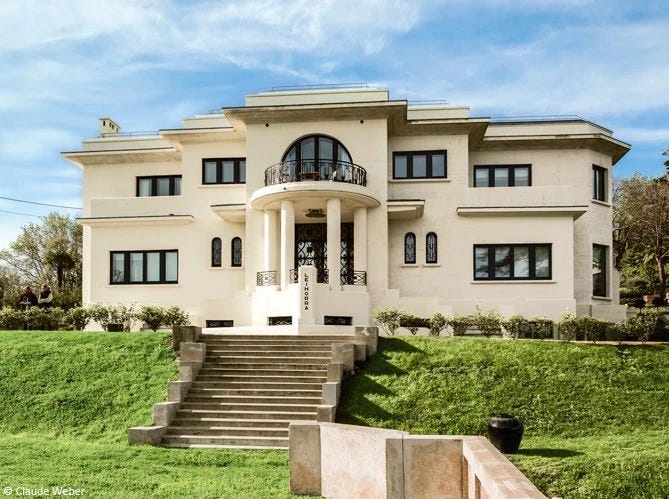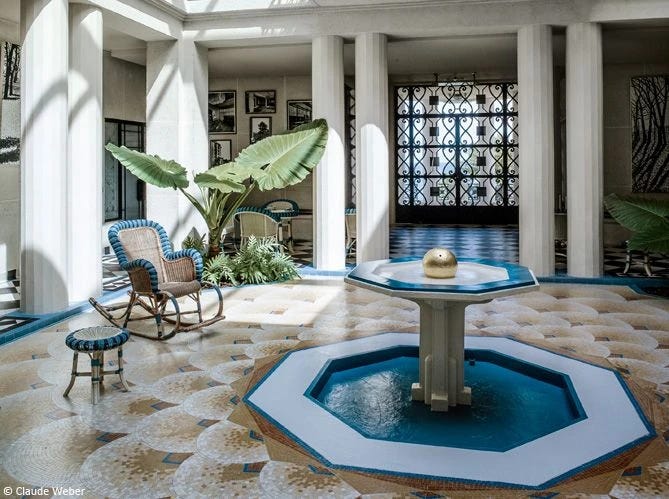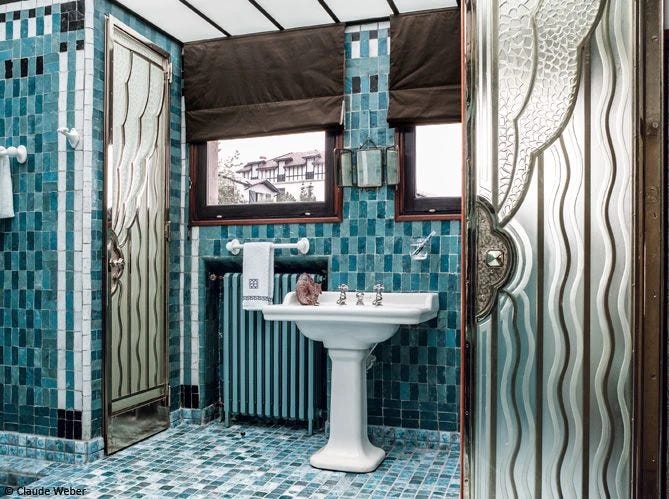Isabelle Roussadana “Roussy” Mdivani was a prominent socialite and member of the famous Mdivani siblings, Georgian-born aristocrats who gained international fame in the 1920s and 1930s for their glamorous lifestyles, high-society marriages, and charismatic presence.
Known for her remarkable beauty, elegance, and charm, Roussy captivated Europe’s elite and became a celebrated figure in Parisian society. Her relationships and friendships brought her close to renowned artists, designers, and influential figures of the era, including Coco Chanel, whose friendship with Roussy was notably long and profound.
Her marriage to the acclaimed Spanish muralist José María Sert brought her further prominence, connecting her intimately to the artistic and cultural worlds of the period.
Through her fascinating journey—from her origins in Georgia to her sophisticated adult life in Paris—Roussy embodied the glamour, creativity, and complexity of an era marked by opulence and cultural dynamism.
Table of Contents: Family Background / Escaping the Russian Pogroms / Paris / The Mdivani Brothers / Practice in Paris / José María Sert / Spain / Coco Chanel / Loss / One more thing…
If you aren’t subscribed yet, hit the subscribe button below to receive the Adorable Stories every weekend, directly in your inbox:
Family Background
Born on July 7th, 1906, Isabelle Roussadana “Roussy” Mdivani belonged to the famous Georgian Mdivani family.
The Mdivanis (Georgian: მდივანი) were apparently a noble family from Tbilisi, Georgia dating back to at least the XVIII century: Mdivani means “Secretary” in Georgian, but the family claimed their name derived from the Persian phrase for “sitting on a divan.”
The Mdivani family claimed to be princes that had made their fortune through oil wells in Georgia.
The best known members of the Mdivani family were the General Zakhari Mdivani (1868-1932) and his wife, the Rasputin confidante, half-Georgian / half-Polish, Elizabeth Viktorovna Sabalewska (1884-1922), and their five children: David, Serge, Alexis, Nina, and Isabelle Roussadana.
All their five children received high-quality education first in St. Petersburg and then in Warsaw, where Zakhari, a general and aide-de-camp of Tsar Nicholas II, used to serve as a commandant.
In 1914, the family moved from Tbilisi to Batumi, where Zakhari Mdivani had been appointed governor of the city by the Tzar Nicholas II: those who were interested in oil business there had to make representations to Zakhari Mdivani.
Escaping the Russian Pogroms
In November 1920, after the Russian Revolution, Zakhari left Georgia to assist Belarusian General Pyotr Nikolayevich Wrangel in the fight against the Red Army during the final phase of the Russian Civil War.
His wife and children also fled Georgia in order to avoid the Bolsheviks pogroms and managed to escape to Constantinople by boat: once reunited, the family emigrated to Paris in 1921 without a penny to their name.
Despite pursuing a large variety of activities and their supposed noble descent, they still failed to avoid poverty in the French capital.
American commentators were often skeptic of the noble origins of the Mdivani family and Roussy did not miss a chance to rebut by showing a photograph of her father with the Tsar to confirm that the Mdivani family belonged to the Georgian high nobility.
However, historical records do not explicitly confirm the precise extent of his wealth or, if existed, how substantial it was.
Nevertheless, the five youngsters were all well educated, aristocratic, tasteful and attractive, and possessed what the press would later call the “Mdivani spell.”
Once in Paris, the Mdivani family claimed to have a royal title — the only evidence being a document issued by Georgia’s government-in-exile that confirmed their noble heritage and their titles of “Tavadi” (Dukes) — and to have abandoned a considerable oil wealth when they fled Georgia.
Paris
At the time, Paris was a welcoming hub for aristocratic émigrés, offering opportunities to rebuild their lives amid a community of fellow exiled nobility, artists, intellectuals, and wealthy socialites.
It was in this vibrant Parisian environment that Roussy and her siblings thrived socially and culturally, quickly becoming prominent figures within European high society.
With an alleged aristocratic lineage, exotic charm, and a flair for luxury, the Mdivani siblings quickly became darlings of the international social scene.
The Mdivani Brothers
Isabelle was closely connected to her celebrated siblings—known famously as the “Marrying Mdivanis”—whose romantic exploits and strategic marriages (often meticulously planned ahead by Roussy) captured headlines in the glamorous social scenes of Europe and America, at a time when rich American heiresses were actively looking to marry into European, often penniless, aristocrats.
Her brothers Alexis, David, and Serge Mdivani were renowned for their charisma, sophistication, and remarkable ability to charm wealthy heiresses, actresses, and socialites, further enhancing the family’s social prominence:
Alexis notably married Barbara Hutton (featured in the Adorable Story #43), the American Woolworth heiress;
David married actress Mae Murray; and
Serge married actress Pola Negri.
These high-profile unions deeply fascinated the public and media alike, particularly in North America.
Roussy shared a warm, affectionate bond with her brothers, frequently appearing alongside them at prestigious events, elite parties, and luxurious gatherings, collectively embodying a symbol of elegance, intrigue, and cosmopolitan allure in the interwar years.
Practice in Paris
In Paris, Roussy worked as a talented sculptor, creating elegant and expressive pieces.
Her sculptures included portraits of notable figures such as US President Calvin Coolidge, Japanese actor Sessue Hayakawa, Ukrainian dancer Sergei Mikhailovich Lifar, and prominent American industrialist August Heckscher.
Additionally, Roussy designed the prestigious Harmon Trophy (photo below), an award presented annually in the United States since 1925 to outstanding aviators.
Although she did not publicly exhibit widely, her artistic contributions earned recognition and appreciation within her influential social circle and beyond.
José María Sert
Roussy was young, tall, sleek, and stunning, with streaked ash blond hair: she also cultivated an image as an eccentric, always accompanied “by two monkeys dressed in rich Oriental brocades and aglow with diamonds and emeralds and other jewels,” wrote her sister-in-law Pola Negri.
She had her Parisian studio in Montparnasse close to that of the Spanish artist José María Sert, who was known as the “Tiepolo of the Ritz,” and who would later paint the murals for New York’s Waldorf Astoria hotel.
When Roussy first met the celebrated José María Sert in Paris, he was already married to Misia Sert.
According to the biographers of Sert’s wife, Misia Sert (born Maria Zofia Olga Zenajda Godebska, 1872–1950)— who was herself a muse to, and friend of, an assortment of artists, from Stravinsky to Renoir to Coco Chanel to Ravel to Proust— Roussy wandered “like a stray cat” into Sert’s studio one day and “was picked up, examined, fondled, and adopted” by her husband.
José María and Misia had been a prominent couple in Parisian artistic circles for many years, famously hosting gatherings attended by leading artists, writers, and musicians.
Initially, Roussy moved in with the Serts as a friend of both, but soon developed a romantic relationship with José María.
Roussy and José María became an odd couple: Roussy, at 19, was an ethereal beauty; José María, at 50, was, as a society reporter described him, “bald and short” and “round-shouldered.”
It was an odd relationship: odder still because his wife Misia had also started enjoying the company of Roussy, befriending her and trying to find her a husband among the Parisian high society.
Apparently, the friendship between Roussy and Misia also turned physical shortly thereafter.
This ménage a trois inspired Jean Cocteau’s 1940 play “Les Monstres sacrés”, Alfred Savoir’s play “Maria” and Chanel’s fashion style “Trio”.
When Roussy fell ill, it was Misia who escorted her from Paris to a sanitarium in Switzerland to convalesce.
It was in Switzerland that Roussy told Misia that she and José María intended to marry.
Misia was shocked, but not enough to break with her husband and Roussy.
Soon afterwards, while the three were vacationing in Venice together, Roussy literally crawled into their room as Misia and José María were making love.
“From that day on, mute and implacable, tragedy shadowed our lives.”
— Misia Sert
After that night in Venice, the ménage a trois quickly unraveled.
With Nina Mdivani’s husband as facilitator, José María later divorced Misia and married Roussy on August 18th, 1928 in a civil ceremony at the consulate in The Hague.
According to her biographers, Misia remained friends with both Roussy and José María. She even helped selecting Roussy’s trousseau at Chanel and, despite her personal devastation, accompanied the newlyweds on their honeymoon through Catalonia and the Mediterranean.
In 1930, Roussy and José María were married in a religious ceremony at the Spanish church in Paris.
Spain
After getting married, Roussy and José María, primarily lived at their luxurious villa in Saint-Jean-de-Luz, located in the southwestern region of France near the Spanish border.
Known as “La Villa Sert” or “Villa Leïhorra,” this elegant residence overlooking the Atlantic Ocean in the Pais Basque became the couple’s preferred retreat from the bustling social scene of Paris.




Villa Leïhorra, designed in an Art Deco style, provided both privacy and picturesque surroundings, allowing José María Sert to work on his artistic projects and Roussy to find solace amidst personal turmoil.
Coco Chanel
During those years in Paris, Roussy shared a close friendship with the legendary fashion designer Coco Chanel, even becoming one of Chanel’s favored confidantes and companions in Parisian society.
Both women were strong-willed, sophisticated, and ambitious, bonding over their mutual appreciation of art, culture, and social elegance.
Roussy frequently appeared in Chanel’s inner circle, and the designer admired her friend’s glamorous style, artistic insight, and sharp wit.
It is said that Roussy, long before the existence of hippies, dressed in “hippie style”, but a very elegant “Chanel” version of it: boots, shiny raincoats, boleros embroidered with colored stones, beanies tuck on the back of her head.
Coco Chanel, known for her selective friendships, genuinely enjoyed Roussy’s company, often hosting her at intimate gatherings and private dinners.
Roussy and Chanel undeniably shared deep mutual admiration, affection, and companionship, frequently spending extended periods together at Chanel’s villa “La Pausa” in Roquebrune-Cap-Martin, a picturesque town on the French Riviera, near Monaco and Menton.
While direct definitive proof of a romantic relationship between Roussy and Coco Chanel has never surfaced, historical evidence strongly suggests that their bond was unusually intense, affectionate, and emotionally charged.
Loss
Roussy’s later years were tragically marked by devastating personal losses that deeply impacted her emotional well-being.
In 1935, her brother Alexis Mdivani —whose marriage to heiress Barbara Hutton Roussy herself had carefully orchestrated— died suddenly in a car accident in Spain.
Just a few months later, in the same year, her other brother, Serge Mdivani died unexpectedly following a polo accident.
These consecutive tragedies profoundly scarred Roussy, who had always maintained a close emotional bond with her siblings.
The sudden loss of Alexis and Serge left her emotionally vulnerable as she struggled profoundly with grief and emotional distress.
She began relying heavily on sedatives and various other substances to cope with her immense sorrow and anxiety, so much that friends and acquaintances, including Coco Chanel, observed with concern her escalating dependence on drugs and her withdrawal from the vibrant social life she once dominated.
This reliance on substances marked a tragic chapter in her life, intensifying her isolation and instability in the late 30s.
In 1938, after her brothers’ deaths, Roussy took a Mediterranean cruise on a sailboat she christened Saint Alexis.
Frail and sick, she suffered from a persistent cough, which was finally diagnosed as tuberculosis.
By one account, her friend Coco Chanel tricked her into checking into a sanitarium in Switzerland to have doctors finally take care of her health, but Roussy, according to friends, no longer had the will to fight.
Roussadana Mdivani died in Vaud, Switzerland on December 16th, 1938. She was only 32 years old.
After Roussy’s tragic death, Chanel reportedly said:
“My life has lost its grace.”
Today, Chanel’s lip colour 426 Roussy is named after Roussadana Mdivani.
—Alberto @
One more thing…
After Roussy’s death, her husband José María reconciled with his first and lifelong companion, Misia Sert.
Their renewed companionship, though not formalized by remarriage, endured for approximately 7 more years, until José María Sert’s death on November 27th, 1945.
Do you know anyone who would love to read this Adorable Story? Show your support by sharing Adorable Times’ Newsletter and earn rewards for your referrals.











